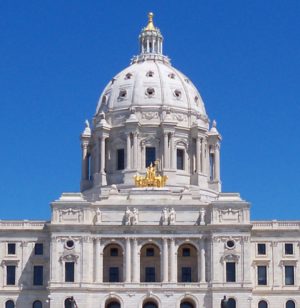by Steve Woods, executive director
To quote Steve Morse of Minnesota Environmental Partnership,
“It was short, intense and accomplished little.”
 The session ended in mid-May. There seems to be no call for a special session at this time. And the Guv’na is done working his pen to make laws or vetoes. Summaries abound, with a quick Google search yielding many results. Here are some highlights, in our book:
The session ended in mid-May. There seems to be no call for a special session at this time. And the Guv’na is done working his pen to make laws or vetoes. Summaries abound, with a quick Google search yielding many results. Here are some highlights, in our book:
1. Dayton signs bonding bill. Gov. Dayton signed a public works package that will spend $1.5 billion on projects like road construction, treatment plant upgrades, and campus repairs. The state will borrow $825 million of that total. He line-item vetoed one provision from the bill, $1 million for analyzing Minnesota Pollution Control Agency water regulations. The governor made it clear he was not 100 percent happy with the bill he was signing, stating that the legislation, “underfunds critical investments in higher education, state parks, and water infrastructure, and assures that those needs will become more urgent and more expensive in the future.”
Disturbingly, the bill uses $98 million from the Environment and Natural Resources Trust Fund, a lottery-funded source approved by voters back in 1998. That funding source had been hinted at for several weeks and popped up in the final hours. Dayton said he didn’t like it, saying raiding the fund was a harmful precedent. But he said he couldn’t block it without also axing important wastewater infrastructure projects. “It was unwise, but it was shrewd,” Dayton said of the legislative maneuver.
We would have liked to see more money in the bonding bill for conservation easements but hope some off-year bonding next session will allow the state to capture the rest of the federal match. It wasn’t entirely clear whether the state could even spend the full requested amount in time so we’re tending to view this as a cash flow decision that additional bonding next year can rectify.
2. Clean Water Fund restored. Last year the legislature pulled $22M out of the Clean Water Fund, after an agreement that was enacted two years ago designated it would come from the general fund. It was a bait and shift — emphasis on the shifty — maneuver that was sour for many groups since it amounted to about 20% of the annual appropriation. In a bit of good news, it was “paid back” this session. However, the inability to pass a Legacy bill this session means the money will just sit in an account all year.
Up next? Our attention has turned to preparing for the 2019 session. Wondering what’s on our minds? We completed a trio of stellar groundwater policy reports this year that address urban, rural, and overall water supply issues Minnesota should be preparing itself to tackle. We also convened 18 interest groups last winter to help envision how the Clean Water Fund and state programs should alter course, now that the original vision for the fund has been largely put into place and is beginning to show a wide range of successes.